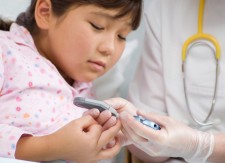
Credit: Shutterstock
Just over a decade ago researchers in the United Kingdom published findings about four white adolescents (three females, one male, ages 13-15) presenting with significant obesity and Type 2 diabetes. The authors offered a cautionary prediction that this clinical presentation - type 2 diabetes was rare in childhood - would become more common.
And it has. According to the National Diabetes Statistics Report released in 2014, approximately 208,000 Americans under the age of 20 have been diagnosed with diabetes. What was once a rare scenario has become so prevalent that the condition is at the center of two recent major clinical trials.
The Treatment Options for Type 2 Diabetes in Youth study (TODAY) published their first results in 2012. The randomized controlled trial comprised 699 adolescents and was aimed at evaluating the efficacy of three treatment options: metformin alone, metformin plus rosiglitazone, or metformin plus intensive lifestyle changes aimed to reduce weight and increase physical activity. Metformin and rosiglitazone were already shown to be safe and effective for treatment of type 2 diabetes in adults, but outcomes in a younger population had not been studied.
The TODAY study found that durable glycemic control with metformin alone was achieved in half of the 10-17 age group studied. However, in combination with rosiglitazone there was improvement in both glucose control and side effect profile.
The TODAY study led to more questions, such as whether or not it could be determined early in the disease course which adolescents would not achieve durable glycemic control with metformin. They compared two groups: those who maintained glycemic control for at least 48 months and those who lost it prior to 48 months.
The authors found that those with an HbA1c greater than 6.3 percent after being treated for three months with metformin had a fourfold increased risk of losing glycemic control. The median time for loss of glycemic control was found to be 11 months. HbA1c, which gives a quantitative value of glycosylated hemoglobin, is commonly used to monitor glucose control in diabetics over three month periods. Interestingly, a value greater than 6.5 percent is considered diagnostic of diabetes mellitus.
The researchers suggest that applying this cutoff value in clinical practice will allow for the identification of two different groups requiring two different modes of treatment. Physicians could identify early on in the disease course those who will require more intensive or additional forms of therapy. And on the other end of the spectrum, for those below the cut off value, unnecessary and/or aggressive therapeutic interventions could be avoided.


